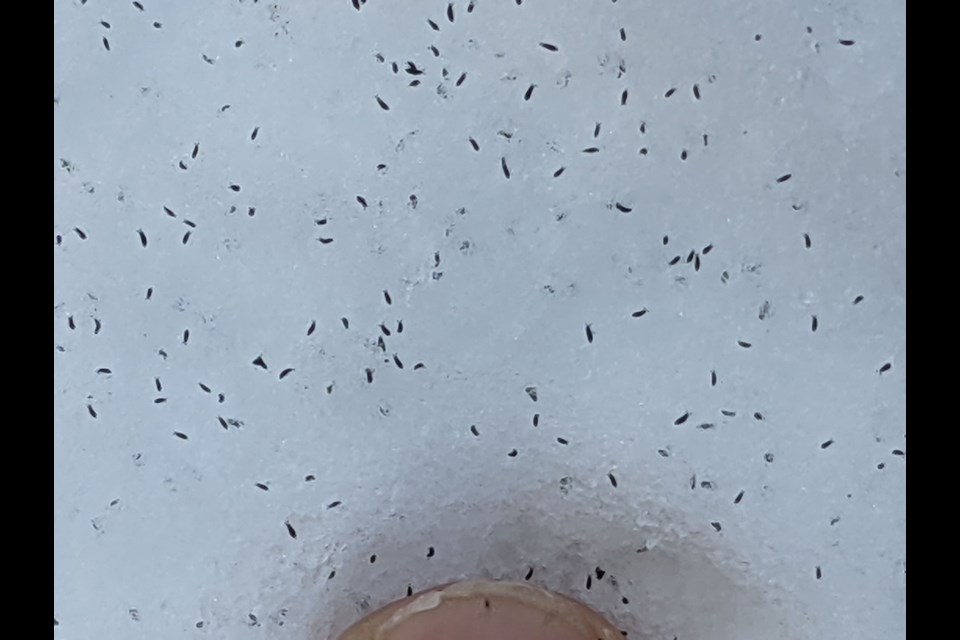Thankfully within winter there are no blackflies and mosquitoes to contend with. There are other insects and, at a glance, they probably look like bits of dirt or pepper but they are tiny soil animals.
“Snow fleas” is a misnomer, more like a truck driver’s ”handle” or a nickname. They are actually quite common and abundant within the other three seasons but they're so tiny that they tend to blend in and go unnoticed until the white stuff arrives.
Better identified as springtails they are not actually fleas or even technically insects, they are arthropods and live in the subnivean environment, they are spotted as the mild spells continue toward the season of revitalization.
Arthropods have more than a million described species, making up more than 80 per cent of all living animal species, some of which like snow fleas are very successful in adapting and surviving quite nicely underneath the layers of snow.
If you like bugs springtails are kind of cute and have fewer abdominal segments than other insects and shed their exoskeletons; are 1 to 2 mm long, have short antennae and two clusters of 16 tiny eyes each.
Snow fleas are wingless insects, incapable of flying; they have a special way of jumping. Snow fleas have the super-powered ability that regular fleas have. Unlike other famous jumping arthropods like grasshoppers, snow fleas don't use their legs, they move more like a medieval catapult.
Snow fleas are equipped with an unusual abdominal appendage, a sort of tail called a “furcula” that is responsible for their long jumps. As the furcula unfolds, it launches - hence the name “springtail.” When they are thrown a few centimetres into the air—a considerable distance for such a tiny creature, they have no way to steer, it's an efficient way to flee potential predators.
Professor Don Henne knows his insects. The entomologist is a faculty member, Natural Resources Department, at Lakehead University in Thunder Bay.
One of his interests in the spatial and temporal population dynamics of insects and other arthropods.
“Springtails are insects and are arthropods. Arthropod means jointed legs, like all other insects, they have six legs,” Henne said.
“The subnivean layer under the snow is actually quite warm, relatively speaking,” he said. “With a layer of snow more than 20 cm thick, the outside temperature may be -40 C, but the subnivean layer at the snow/ground interface will hover around the freezing point.
"Springtails will move up and down the snow layer, depending on the outside temperature. If it's warm outside, they will move up and be visible on the surface of the snow.
"When the temperature gets too cold for them, they move back down where it's warmer.
"Springtails normally live among leaf litter and other decomposing organic matter on the ground where they feed on, fungi, algae, mould, bacteria and decaying organic matter. Despite their great abundance, we rarely see them except on warm days during the winter when they appear on the snow.”
He said in the winter, the two species of tiny black flecks — Hypogastrura harveyi and Hypogastrura nivicol — can be easily spotted against the white backdrop of snow.
Unlike fleas, springtails are not parasites they play an important part in the process of natural decomposition. Springtails are an important food source for many small invertebrate predators.
And if you have ever seen small birds seeming to eat snow, they may have been dining on springtails. If you see these black patches on your lawn or garden they are actually great because of the work that they do to help decompose organic material.
Take it as a good sign that the ecosystem in your yard is healthy and rich in organic material.
Snow fleas are important within the scientific research community because they have developed a powerful set of molecular helpers that allow them to remain active during the winter deep freeze; two antifreeze proteins (AFPs- Alpha-fetoprotein), rich in the amino acid glycine.
It allows snow fleas to keep on munching organic materials despite the colder weather. It prevents the formation and enlargement of ice crystals, lowers the freezing point of its body fluids by nearly 6 °C.
The proteins, isolated and sequenced by Laurie Graham and Peter Davies of Queen's University are among the most effective AFPs ever observed. They have determined the protein binds to the ice crystals during the formation phase preventing the crystals from growing larger.
The finding helps shed light on AFP evolution in insects and could lead to potential protein-based antifreeze applications. This may allow human organs to be stored at lower temperatures, expanding the time allowed between removal and transplant.
It could also help to increase frost resistance in plants, and inhibit crystallization in frozen foods. Snow fleas have their place like every other living creature.
We are not at the end of a bug-free winter, that is one of the attributes of March winter camping. Whatever you like to call them it is a thrill to spy a group of springtails hopping along what we think is dirty snow; have a look with your phone’s magnifier app.
Yes, the insects that do bite are just around the corner and we are all looking forward to that, especially this year as we get back to the back roads.
